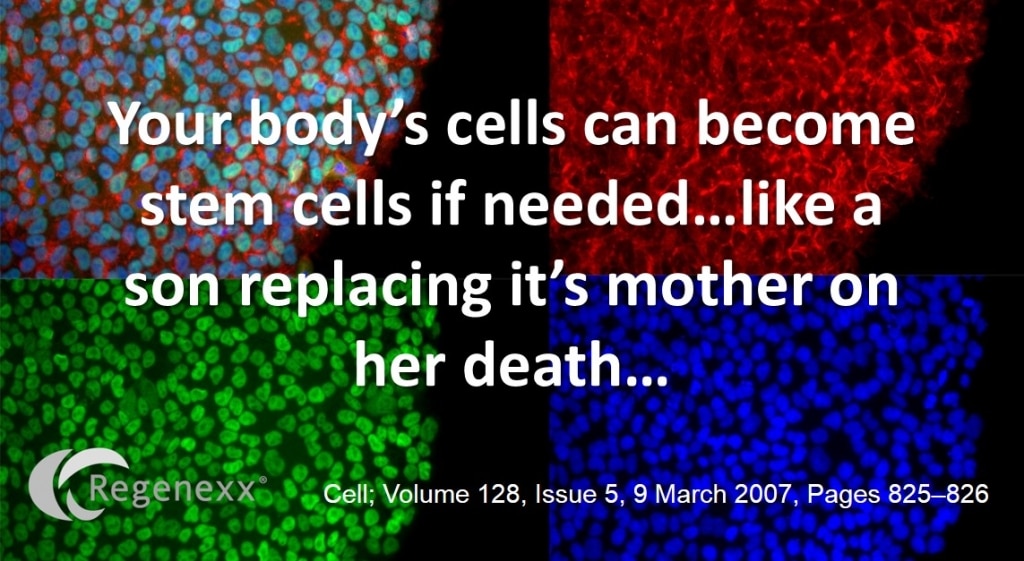If Your Were a Stem Cell You Could Replace Your Mother…
There’s been a great flurry of attention about iPS cells (induced pluripotent stem cells). These artificial, lab created stem cells seemed to be a unique manufactured article of man, but I recently came across research that would suggest otherwise. The concept of more differentiated cells going backwards to stem cells exists in nature.
First, the major defining concept of an adult stem cell is that it’s held in reserve in tissues and can differentiate (read “become”) a cell type that is lost to aging or is killed off through trauma. Without adult stem cells doing this, since your cells are being constantly killed off, you wouldn’t live long. In fact, the short life of radiation victims from Hiroshima and Nagasaki is what prompted the discovery of stem cells after world war II, as scientists struggled to understand why these people died from an invisible agent. Scientists by the 1960s were able to irradiate rats and kill off their bone marrow and have the animal live through marrow donation form another rat. It was this re-population of the irradiated rat’s bone marrow that led researchers to isolate the cells responsible-stem cells.
iPS cells are another matter. Scientists discovered that they could “re-program” the somatic cells that make up the structure of your body so that they revert back to an embryonic like stem cell. This discovery seemed to fix two important issues with stem cells. The first was the ethical debate over embryonic stem cells. The second was the fact that the US Patent Office doesn’t issue patents on something that exists in nature and is discovered like a new protein or a stem cell. However, an artificially created stem cell that doesn’t exist in nature can be patented. However, if iPS cells do exist in nature, then their patent-ability could be called into question. Enter an interesting bit of research from the journal Cell from a few years back.
The paper asked the question of what would happen if all of the adult stem cells died in a tissue? In other words, what would happen if all of the reserve and replacement cells were dead? A Japanese author (Nakagawa), who later became active in iPS cells, was able to demonstrate that in that instance, the differentiated cells that came from stem cells were able to go backwards and replace the dead stem cells. Since then, other authors have found similar things, indicating that the differentiation of stem cells into other cell types is a fluid process that works as well in reverse as is does in a forward direction.
All of this gets even more interesting with the concept of stem cell transdifferentiation. For example, it’s often discussed that fat tissue has more “stem cells” (meaning mesenchymal stem cells) than bone marrow. However, bone marrow is rich in hematopoietic stem cells, while fat tissue has none. This stem cell type normally makes blood cells, but a number of studies have now shown that they can also participate in many of the repair feats of mesenchymal stem cells through transdifferentiation (by becoming another stem cell type). This is likely why we don’t see much additional benefit to fat stem cells when they’re added to bone marrow stem cells, as the bone marrow has more than enough of the “good stuff”.
The upshot? To put the wierd world of stem cells in perspective, let’s use human analogies. It’s as if a young son could replace his mother on her death by turning into her to bear more children. Or if that same analogy were applied to stem cell transdifferentiation, that the same son could become a cousin in the absence of the cousin, instantly acquiring all of the cousin’s skills. What is clear about all of this is that the concept behind iPS cells is prevalent in nature and that your body has many built in mechanisms to “make due” when the right cell isn’t around! How all of these discoveries impact iPS cell patents remains unclear, but could prove interesting!.

If you have questions or comments about this blog post, please email us at [email protected]
NOTE: This blog post provides general information to help the reader better understand regenerative medicine, musculoskeletal health, and related subjects. All content provided in this blog, website, or any linked materials, including text, graphics, images, patient profiles, outcomes, and information, are not intended and should not be considered or used as a substitute for medical advice, diagnosis, or treatment. Please always consult with a professional and certified healthcare provider to discuss if a treatment is right for you.

